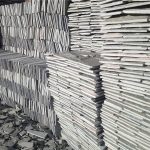Introduction:
When it comes to enhancing the aesthetics and durability of interior and exterior spaces, cultured stone panels have become a popular choice among homeowners, designers, and architects. mosaic tile and stylish panels offer the timeless elegance of natural stone while providing practical benefits such as ease of installation and maintenance. In this comprehensive guide, we will explore the world of cultured stone panels, from their origins and manufacturing process to their applications and advantages.
Origins and Manufacturing Process:
Cultured stone, also known as manufactured stone or faux stone, is a man-made material designed to mimic the appearance of natural stone. The concept of cultured stone dates back to the mid-20th century when a process was developed to create lightweight, durable, and cost-effective alternatives to natural stone.
The manufacturing process of cultured stone panels involves mixing cement, aggregates, and iron oxide pigments to create a moldable material that can be shaped and textured to resemble various types of natural stone, such as limestone, slate, granite, and travertine. The mixture is poured into molds that are lined with a release agent to prevent sticking, and then cured to harden and set. Once the panels are fully cured, they are removed from the molds and finished with coloring and texturing techniques to achieve a realistic stone-like appearance.
Applications:

Cultured stone panels can be used in a wide range of interior and exterior applications to enhance the beauty and functionality of residential and commercial spaces. Some common applications of cultured stone panels include:
1. Exterior Cladding: Cultured stone panels are often used to create stunning facades for buildings, homes, and outdoor structures such as fireplaces, columns, and accent walls. The panels provide the look of natural stone while offering enhanced durability and weather resistance.
2. Interior Walls: Cultured stone panels can be used to create feature walls, accent walls, and backsplashes in interior spaces such as living rooms, kitchens, bathrooms, and entryways. The panels add texture, warmth, and visual interest to any room.
3. Fireplace Surrounds: Cultured stone panels are a popular choice for fireplace surrounds, offering a rustic and elegant look that enhances the ambiance of the room. The panels can be customized to match the style and decor of the space.
4. Outdoor Living Spaces: Cultured stone panels are ideal for enhancing outdoor living areas such as patios, pool decks, and outdoor kitchens. The panels are resistant to moisture, fading, and staining, making them a durable and low-maintenance option for outdoor applications.
Advantages:
There are numerous advantages to using cultured stone panels in interior and exterior design projects. Some of the key benefits of cultured stone panels include:
1. Cost-Effective: Cultured stone panels are typically more affordable than natural stone, making them a cost-effective option for homeowners and builders looking to achieve the look of stone without breaking the bank.
2. Lightweight: Cultured stone panels are lighter in weight than natural stone, making them easier to handle and install. This can result in lower installation costs and reduced structural requirements.
3. Durable: Cultured stone panels are highly durable and resistant to weather, moisture, fading, and staining. This makes them an ideal choice for exterior applications where natural stone may be prone to damage.
4. Versatile: Cultured stone panels are available in a wide range of colors, textures, and styles, allowing for endless design possibilities. Whether you prefer a modern, traditional, or rustic look, there is a cultured stone panel option to suit your aesthetic preferences.
5. Easy to Install: Cultured stone panels are designed for easy installation, with interlocking systems that simplify the process and reduce labor costs. Most panels can be installed using basic tools and techniques, making them a DIY-friendly option for homeowners.
6. Low Maintenance: Cultured stone panels require minimal maintenance to keep them looking their best. Regular cleaning with a mild detergent and water is typically all that is needed to maintain the panels' appearance and longevity.
Conclusion:
Cultured stone panels offer a cost-effective, durable, and versatile alternative to natural stone for interior and exterior design projects. With their realistic appearance, ease of installation, and low maintenance requirements, cultured stone panels have become a popular choice among homeowners, designers, and architects seeking to enhance the beauty and functionality of their spaces. Whether used for exterior cladding, interior walls, fireplace surrounds, or outdoor living areas, cultured stone panels provide a timeless elegance that can transform any space into a work of art.
